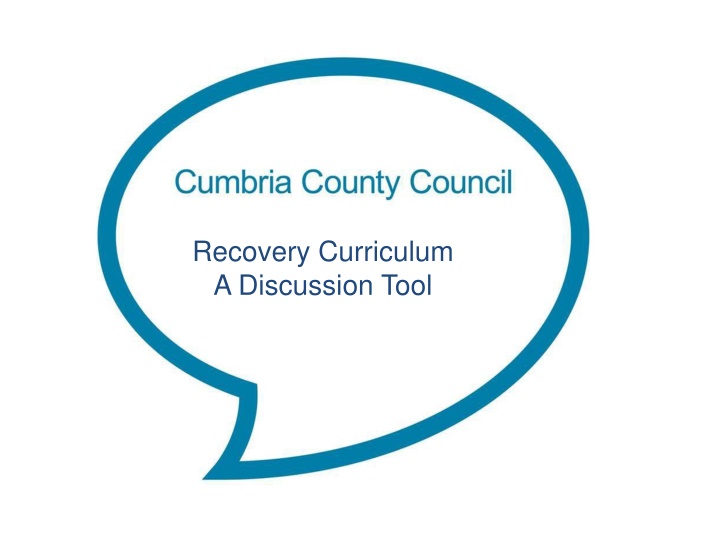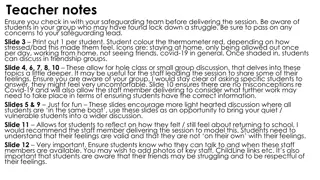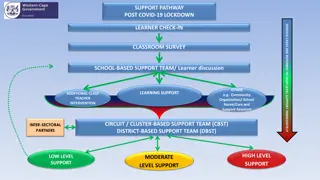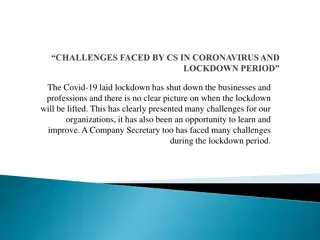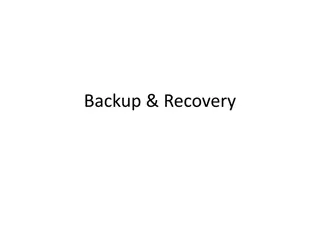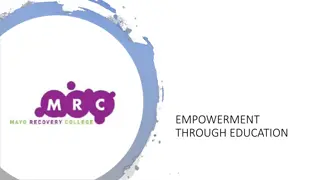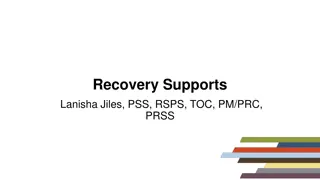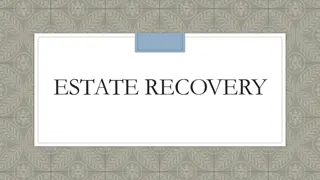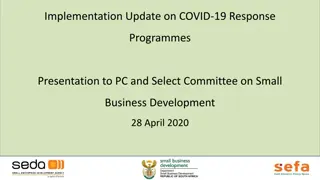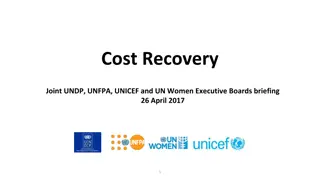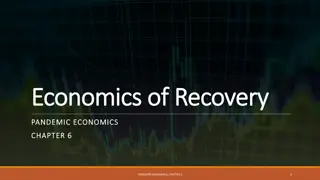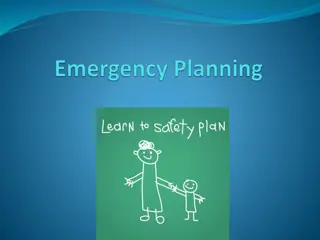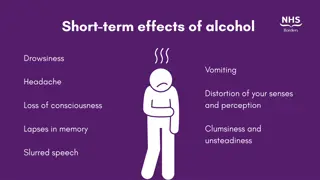Impact of COVID Lockdown on Students & Recovery Curriculum Discussion
The COVID lockdown may have varied impacts on students, from loss of routine to trauma. The Recovery Curriculum is essential for planning post-pandemic strategies, focusing on relationships, community engagement, transparent curriculum, metacognition, and creating space for students to rediscover themselves. Addressing these aspects can help students transition back to school effectively.
Uploaded on Feb 19, 2025 | 2 Views
Download Presentation

Please find below an Image/Link to download the presentation.
The content on the website is provided AS IS for your information and personal use only. It may not be sold, licensed, or shared on other websites without obtaining consent from the author.If you encounter any issues during the download, it is possible that the publisher has removed the file from their server.
You are allowed to download the files provided on this website for personal or commercial use, subject to the condition that they are used lawfully. All files are the property of their respective owners.
The content on the website is provided AS IS for your information and personal use only. It may not be sold, licensed, or shared on other websites without obtaining consent from the author.
E N D
Presentation Transcript
Recovery Curriculum A Discussion Tool
The COVID lockdown may have had minimal effect on some students, but be traumatic for others. First, let s think about potential impacts on a whole cohort level . Loss of structure and routine Self-esteem and self- image affected by lack of peer group interaction (esp. teenagers) Vulnerability to adult anxiety Loss of friendships/interaction (can trigger bereavement response) Televised reports of pandemic spread and death tolls School is no longer safe and consistent. Loss of freedom (especially teenagers) Loss of opportunity (exams, rites of passage- leavers, transition, celebrations, residentials.) Serving the people of Cumbria
The Recovery Curriculum is an essential construct for our thinking and our planning. Each school must fill it with the content they believe is best for the children of their school community, informed by your inherent understanding of your children in your community. What were the aims and values of your school before this pandemic? Use them now to guide your judgements, to build a personalised response. A Recovery Curriculum: Loss and Life for our children and schools post pandemic. Matthew and Barry Carpenter- 2020. Serving the people of Cumbria
Carpenter suggests that the recovery curriculum has 5 levers or areas: Relationship Community Transparent curriculum Metacognition Space Serving the people of Cumbria
Lever 1: Relationshipswe cant expect our students to return joyfully, and many of the relationships that were thriving, may need to be invested in and restored. We need to plan for this to happen, not assume that it will. Reach out to greet them, use the relationships we build to cushion the discomfort of returning. Lever 2: Community we must recognise that curriculum will have been based in the community for a long period of time. We need to listen to what has happened in this time, understand the needs of our community and engage them in the transitioning of learning back into school. Lever 3: Transparent Curriculum all of our students will feel like they have lost time in learning and we must show them how we are addressing these gaps, consulting and co-constructing with our students to heal this sense of loss.
Lever 4: Metacognition in different environments, students will have been learning in different ways. It is vital that we make the skills for learning in a school environment explicit to our students to reskill and rebuild their confidence as learners. Lever 5: Space to be, to rediscover self, and to find their voice on learning in this issue. It is only natural that we all work at an incredible pace to make sure this group of learners are not disadvantaged against their peers, providing opportunity and exploration alongside the intensity of our expectations. Try a SWOT analysis in relation to 5 levers above. See activity 2. Matthew and Barry Carpenter, Think piece 2020
Trauma reflects social inequalities 1 Public Health England s report into COVID disparities has shown that BAME groups, people with underlying health conditions and people in areas of high deprivation have greater mortality rates if infected. Trauma will be disproportionately affecting these groups a) through direct personal experience of COVID or b) due to fear of infection this could affect children, parents, wider family In Cumbria BAME and EAL pupils may also feel isolation from being a majority white environment, many will have been influenced by Black Lives Matter work that reflects issues of race in society can help to integrate minority groups into rebuilding the school community.
Trauma reflects social inequalities 2 Children who have underlying health conditions i.e. diabetes and asthma, or children who are obese may feel more anxious about exposure to COVID, the same for children where this applies to family Autistic children and young people have particularly struggled the loss of structure and other children with special needs have been vulnerable to trauma Children with disabilities including mobility impairments and sensory loss may require additional support finding themselves within a changed physical environment
Trauma Informed Recovery- an alternative approach Impact of: Loss of connection Loss of structure and BereavementAnxiety routine Loss of opportunity Loss of freedom Attachment Serving the people of Cumbria
The 5 Pillars of Recovery from Trauma and practical steps Create a sense of safety: Provide clear and simple information about new routines. Use visuals or ask children to help create visuals to support. Involve children in considering how best to support adherence to the new rules, e.g. by designing a socially-distanced classroom for Year X pupils, or by making posters to share the rules with others. Pupils debate and defend their designs. Re-establish familiar routines and introduce new activities. Develop transition work. Provide opportunities for children to talk and ask questions. Consider a worry box/ monster.
Create a calming environment Schedule time to complete a grounding activity at the beginning of the school day, such as tutorial time, a shared story, news or circle time. Schedule time to complete calming activities, such as listening, reflection or mindfulness. Develop self- efficacy Provide opportunities and encourage children to take part in decision making where possible. Allocate responsibilities within the new class groups. Be positive about what CAN be done, e.g. sports, arts and music.
Talking and listening through debates PSHE friendship work Help children re- establish friendship groups Develop new ways of playing, undertaking sport or socialising in socially distanced way Build Connections and Offer Hope Share good news Opportunities to share experiences Provide opportunities to develop new/different skills Serving the people of Cumbria
Supporting Pupils To Return To School Things to keep in mind You are part of a team. One size doesn t fit all Your team is wider than your school community Different emotional responses. Serving the people of Cumbria
The domestic abuse charity Refuge cited a 700% increase in calls to their helpline. What challenges have some of your students faced at home? For some pupils being at home has been a welcome respite from school. How might you engage these pupils? Serving the people of Cumbria
Practical Strategies Allow time to talk- including opportunities for individuals. Phase gradually from creative to more academic lessons. Add more PSHE type lessons. Keep offering opportunities to talk not just in the first week. Acknowledge challenges and losses, but have a positive approach to the future and build relationships. Rebuild a sense of connection Use music, art and drama Serving the people of Cumbria
Planning ahead- Leadership Leadership in recovery is different from response although remaining challenging and requiring flexibility. Key differences: Uncertainty: You have to try to imagine the future when you are in an environment that is uncertain and rapidly changing. You have to make important decisions with limited evidence and do it with confidence. Scale: The size and complexity of what needs to be done can be overwhelming. Every aspect of life changes Time: Decisiveness and the ability to make good decisions quickly. Part of that is making everyone feel included in the process. It s a balancing act between those things Psychology: Impacted populations work differently. Chronic stress negatively impacts relationships, problem-solving, creative thinking, ability to take on information As people get worn down, trust, cohesion and niceties can be lost Endurance: This is not a marathon, this is not a sprint, this is not a relay. It's every horrible endurance event that you can imagine all rolled into one
Planning ahead How will we ensure students are supported if self- isolation of a year group occurs? Do we keep continue to use online learning for home work? How do we continue to support adherence to social distancing advice by staff, pupils and parents? Is it our role? Review the diversity profile of the school who are our EAL and BAME pupils, who are our pupils with underlying health conditions or disabilities are we promoting diversity and inclusion?
Planning ahead How will we ensure students are supported if self- isolation of a year group occurs? Do we keep continue to use online learning for home work? How do we continue to support adherence to social distancing advice by staff, pupils and parents? Is it our role? Review the diversity profile of the school who are our EAL and BAME pupils, who are our pupils with underlying health conditions or disabilities are we promoting diversity and inclusion? Serving the people of Cumbria
